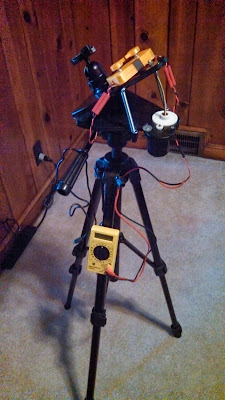It's been quite a while folks.
I've moved to a great (although bright) city just south of Pittsburgh and have settled into full time dad/homemaker, which is kind of awesome honestly. I've made tons of great new friends one of whom is a super tech savvy dude who has taken hours of his own time to help my engineering challenged self tune up my near fatally flawed home built Barn Door sky tracking mount. (More info here:
Gary Seronik Tracking Mount). His own blog is here:
OnShoulders, so take some time to brows the videos about 3D printers, remote controlled airplanes and helicopters, among many other DIY techie goodness.
First some pictures of the homemade beauty then I'll explain a bit.
We (well, really
HE) had to modify the circuitry a tad. There's now two potentiometers and an attached multimeter. The two potentiometers (which are beautifully encased with knobs and box 3D printed in my friend's basement) give very fine control over the voltage going to the motor, which is displayed on the multimeter. As long as we keep the 3V motor running at...you guessed it, 3V it will rotate the large gear at (nearly enough) 1 RPM, which in turn moves the platform in sync with the sky. We may have a few kinks but I think it is working as well as my construction will allow. We are thinking of other options for our own design taking from the newer line of tracking mounts (See
iOptron SkyTracker).
So, basically, you line up the hinge with Polaris (I use a green laser...watch out for planes), then point the camera at an object, set your intervalometer to take continuous shots, engage the gears, and sit back and enjoy the sky for a few hours letting the mount do the work.
Here's a couple shots from 10/8/13. Remember, these were taken under very light polluted skies, more definition will improve when we take her to a darker sky site such as nearby
Mingo Creek Park. The star bursts in the Pleiades image are due to my low quality 300mm lens, you work with what you have. I'll try a wider f-stop next time to see if it improves.
 |
Andromeda Galaxy (M31)
230 frames stacked in DeepSkyStacker
300mm, f8, 34sec ISO800 |
 |
Pleiades (M45)
105 frames stacked in DeepSkyStacker
300mm, f8, 34sec ISO800 |
Hopefully it won't be so long before you hear from me again. Looking forward to seeing Orion again (at a resonable hour).























